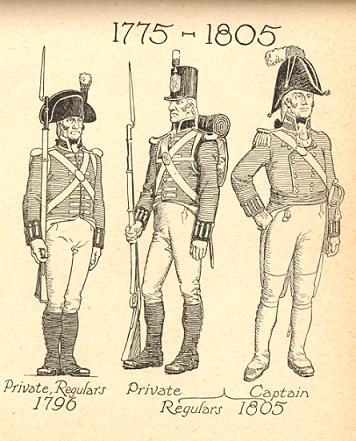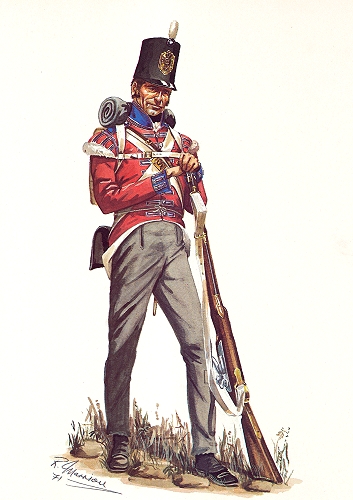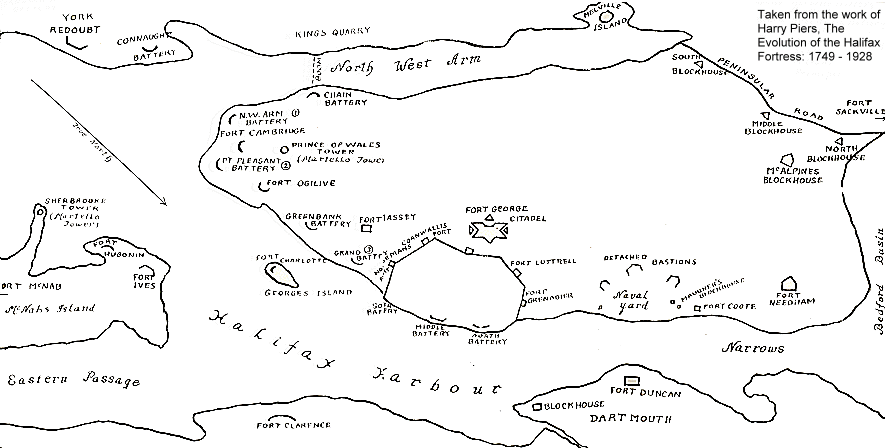
 Book #2: Settlement, Revolution & War.
Book #2: Settlement, Revolution & War.
A general description of the effects of The War of 1812 on the people of Nova Scotia was given by the local historian, Beamish Murdoch:
"The effects of the war upon this province, and particularly upon the people of Halifax, were very marked. Always sympathizing closely with the national glory of Great Britain, they were now drawn more than ever to feel a lively interest in military and naval transactions. The operations of the combatants were brought much more near than ever, and on the sea were more frequent. Our harbour had become the temporary home of the ships of war, and the place where their prizes were brought and disposed of. Our youths were eager to participate in the path that seemed to lead, by a few short steps, to honor, glory and fortune; and indeed when it is borne in mind that four or five Halifax lads rose to be admirals, we can hardly wonder at the school-boy's desire to wear the white stripe on his collar and the little ivory hilted dirk that indicated his authority to command men. The little capital, then occupying a restricted space, became crowded. Trade was active. Prices rose. The fleet increasing, provisions were in great demand, and this acted as a large bounty in favor of the agriculturist and the fisherman. Rents of houses and buildings in the town were doubled and trebled. A constant bustle existed in our chief streets. Cannon were forever noisy. It was a salute of a man-of-war entering or leaving, practising with guns, or celebrating something or somebody. The events of the contest in Europe, from 1811 to 1815 were almost, in aspect, a melo-drama, yet serious tragedy in truth. What was most popular at this period here, I may justly say, was the British navy. Their courageous and adventurous life, - their unsophisticated manners, - their good-hearted, reckless generosity, and even their little faults and aberrations won them a place in the esteem and affection of our people. Their quaint phrases were re-echoed, and even their prejudices sometimes adopted."1Though written a dozen years after the end of The War of 1812, Moorsom was to record that there was "harmony, and good feeling subsisting between the garrison and inhabitants of Halifax ..."2 On summer nights the whole population turned out to hear the regimental band. One of the great functions of the week was the Sunday church parade of the garrison to St. Paul's Church, which had been built from timbers brought up from Boston in 1749, the year that the British had established Halifax. On these occasions the scarlet and ermine of the chief justice vied in splendour with the gold lace of the admiral and of the general.
Halifax through war years -- then and ever since -- was always well supplied with goods that filled the holds of merchant ships. Directly the war broke out in 1793, two French Prizes were brought into the Halifax Harbour on the 2nd April by H.M. Ship Alligator, with cargoes valued at £40,000.3 Throughout the war, those at Halifax were not about to starve. In some commodities, Nova Scotia was better supplied than England.4 Flour, for example, headed for the bakeries in France, was taken out of the holds of captured vessels (prizes) in great quantities and dumped on the Halifax market. Halifax benefited not only simply by the availability of the goods from the ships seized, but because the coming in of more and more prizes reduced the prices of such goods at Halifax.5 Not only was flour available for the baking of fine breads, but also there came by the same route, wine and brandy, and fine linens from Ireland.
The Naval Dockyard:
Latitude 44º39'26" North, longitude 63º37'48" West: this is the position an ocean navigator would give if asked for the location of His Majesty's Dockyard, Halifax. It is not likely that such a precise nautical location could have been given back in 1759, when Governor Lawrence signed over a piece of land on the Western shores of Halifax harbour. I am not able to say how large this first piece of land might have been, but 20 acres was added on in 1783. For the "intent and purpose" of a "hospital for the reception of sick and hurt seaman of H. M. Royal Navy."6 In 1790, more land was added for a Careening Yard, and in 1814, more land was taken for the admiral's residence.
The establishment of a dockyard meant a great deal to the people of Halifax. It was a source of employment.
Military Uniforms:
In April of 1808, Sir George Prevost arrived at Halifax bringing with him 3,000 soldiers. The troops sent with Prevost were meant to reinforce both Bermuda and Nova Scotia. The ship Penelope, in which he embarked, had the transports under her convoy, one of which parted company three days after they left Spithead. In any event all the soldiers reached Bermuda during March. Leaving the 13th Regiment behind, the rest made a stormy passage to Halifax.13 A few days after their arrival, one of the regiments, the 101st, marched off to Annapolis Royal. Prevost brought with him his commission signed by Castlereagh making him the Lieutenant Governor of Nova Scotia replacing Wentworth. Wentworth had no advance warning that he was to be replaced. The official notice of the appointment, addressed to Wentworth, came in a ship 18 days after Prevost's arrival.
Halifax then was to see more soldiers than it had seen for a considerable period of time and at a point when the uniforms were changing. Up to this point, the British soldier had a cocked hat, pigtails, breeches and gaiters.14
"Between 1790 and 1800 the uniform of the British infantry underwent drastic change. In 1800, the cocked felt hat was replaced by the shako or cap of black lacquered leather 7 in. high with a black leather peak. ... In 1806, the leather cap was replaced by a felt shako of similar shape and dimensions, with a black lacquered leather peak. This was commonly referred to as the "stove pipe" shako."16
As for naval uniforms: it was during the times of Anson, the father of the British navy, that a standard was laid down, but "it was many years before the bulk of them readily conformed to it."17 Frocked coats and breeches were the rule with differences in rank shown by the shape and cut of the lapels and cuffs. It was after the time under review, in 1825, that Jackets and trousers came. In 1833 peaked caps with cap badges were introduced.18
In 1798, Prince Edward put names to all of the major defensive installations in and around the Halifax Harbour.
Impressment, viz. forcing young men into military service, came about because of the ongoing problem of desertion which left the ranks and the decks with fewer men than needed for operational efficiency. In September of 1803, the desertions from the army at Halifax, the 60th regiment, were numerous. Often the top commander would offer to pardon deserters24, they need but return, apparently few ever did. The communities along the shore, especially south of Halifax such as Liverpool, were continually warned by circular letters to not assist these young men.25 The magistrates were urged to make every effort in the apprehension of deserters, especially those from the navy, by threatening impressment of an equal number from the boats and vessels in their community, unless they gave the requested aid in the apprehension of deserters.26
Impressment was a rough-and-ready method of recruitment. It was thought that there was no disservice to the community to take into the navy or army "vagrants, and men who could not give a satisfactory account of themselves, and giving them the option of serving His Majesty or going to prison."27 More likely, no options at all were given: "These raids on seamen were not always conducted on 'rose-water' principles, and the slightest resistance met with a cracked crown, or worse."28 From Perkins diary, we read: "27 June, 1805, ... There is a boat on shore from the armed schooner and the people are apprehensive of a press which makes some rumpus. Three black men come & take shelter in my house and said they were chased by the men of war people."
Once a seaman was impressed into the Royal Navy, he was in His Majesty's service until the crew was paid off29, say, at the end of the war. In the army it was a little different. Back then, the law provided that, for a certain time period beyond the enlistment, a man could get himself released. What was necessary was to return the money -- refereed to as the King's shilling -- given to him at the time he signed on, plus an additional sum which was called smart money. Trouble was that these young men rarely had any money. So, it was usual for the young man's family to come up with the necessary funds. The total sum was paid to the enlistment officer who would normally divide it among his recruiting party. Perkins in his dairy, in an entry dated July 21st, 1804, made reference to a young man by the name of Peter West, who "in a fit of intoxication enlisted himself with Sergeant Paterson of the Nova Scotia Regiment by taking ... cash." Next day West made the rounds to obtain smart money so that he could buy himself out of the commitment. Perkins contributed.
The civil authorities, while ready to assist in the apprehension of deserters, were against press gangs going through the community and sweeping up their young men.30 Fishing communities were particularly vulnerable, as the whole community depended on their young seamen to sail the boats on fishing and trading trips.31 The naval captains, while always on the outlook for experienced seamen, understood that they could not drain communities that supplied their ships with wood, water and victuals. What was needed before a press gang went about to do its business was a warrant to do so. A no less important personage then the admiral himself would request leave to impress seaman, and the lieutenant governor and council would grant leave for a stipulated number of days. For example, on May 4th, 1805, Vice Admiral Andrew Mitchell wrote to the Lieutenant Governor and complained that the local people are assisting deserters. The ships under Mitchell's command were deficient of men. He required a warrant for a six month period.32 Wentworth and council granted fourteen days.33
Press warrants were requested where normal recruiting measures were not working. The normal approach would be for an officer with a few men to come to a community and set up shop. Perkins made this entry on September 7th, 1795: "The Snow, Earl of Moira, Capt. Croskill, arrived from Halifax. ... A Man of War Officer, said to be a Lieut., in quest of Seaman, came on Shore. They set up an advertisement at Mr. Phillips for entering Seamen, at £8 bounty."34 The larger record discloses that a number of press warrants were issued through the war years. On June 23rd, 1800, "A warrant to impress 30 men granted to Captain Murray." And again, "30 April, 1803, Saturday. Press warrant for 50 men, to be in force ten days, granted Captain Bradley, HMS Cambrian."35
The requirement of a press warrant did not, at times, stop captains sending a gang ashore to grab needed men. What they would do is look around and when a likely candidate came in view a cry would go out that they had found themselves a deserter. In such circumstances, the citizenry of Halifax were ready to come to the young man's rescue. There is a letter dated July 30th, 1813, at Halifax, from Richard Tremain to Lt.-Gov. Sherbrooke. In it, Tremain explained his conduct in an affair which had resulted in a naval captain charging him with heading a mob in rescuing a deserter. Tremain denied the charge and told his story of what happened. "Your Excellency will at once see the difficulty a Magistrate has to perform his duty if sailors arm'd with Clubs are allowed to range the streets of Halifax, take hold of whom they please, call them deserters, and at once take them to beat those or others that interfere without control."36 Sherbrooke sides with the citizens and advised by letter dated August the 7th to Rear-Admiral Griffith that he caused to have an inquiry made, the results of which he enclosed with his letter. Richard Tremain, as a magistrate in the town, was doing his duty and the navy shore party "have undertaken to exercise a power of impressment on shore without authority and have disturbed the peace and tranquility of the Town by their improper Conduct." Sherbrooke effectively ruled that they cannot get around proper impressment procedure by calling a likely man to be a deserter and then carry him off to a man-of-war riding in the stream. The laws of this province, Sherbrooke advises the Admiral, are to be obeyed. Basically, and the navy well knew the law, an application must be made to the governor or his nominee for a license to impress men in Nova Scotia, and, it may be granted upon proper grounds. "It has been observed," Sherbrooke continued, "and I believe with great truth, that His Majesty's Service here during the present War with the United States would be much benefited by the entire discontinuance of impressment in this port." He transmits a volume of the provincial statutes for the Admiral's information."37
Men who privately owned sailing vessels for fishing or trading were careful to carry all the necessary licenses. These licenses, issued by the government which was plainly on the side of those who were just making a living, were not so difficult to obtain.38 Certificates were also secured for seamen. Perkins wrote on May 23rd, 1803, of an occasion when two schooners had sailed from Liverpool, "I [in his capacity as a town magistrate] gave them certificates for their men that they belong to Liverpool and its neighbourhood. They carry ten men each."
The large naval vessels competed with their smaller brethren and with privateers for crew. These commerce raiders usually had little trouble getting a crew together. Promises were made of adventure and riches. Advertisements appeared in the paper, such as: "All tight Lads, Who are willing to serve his Majesty in that fast-sailing, excellent sea boat, the Canso, of 12 guns, commanded by Lieut. Croake, now fitting out for a short cruise, to protect the Trade of the British Provinces and pick up a few straggling American Bordeaux-men, will meet with an honest, hearty welcome, from a Sailor's Friend, by applying on board that vessel, at the navy yard." Another: "While King, Country and Fortune point to the Ocean! - His Majesty's Schooner Pictou, of 12 guns, commanded by Lieut. Stephens, as fine a vessel of her size as ever floated on salt water, wants a few jolly, spirited fellows to complete her complement for a short cruise, who may all fairly expect to dash in Coaches on their return, as well as other folks! Apply on board, at the navy yard."39
"To them the employment of a large force of workmen, not only offered advantages in supplying materials and provisions7, but it tended to make the visits of the ships of the navy more frequent, and in every way promoted business, while at the same time, it was a practical and distinct pledge and proof of the value England set upon the colony, and the interest she felt in its welfare. ... The officers of the navy in general liked this Station, preferring it much to Bermuda. The climate of Halifax was more congenial to them, -- the community larger, -- provisions cheaper and more various; and the opportunity for sport with the gun or line, or excursions inland, increased their desire to revisit it."8
Well, while it might be that the officers of the navy in general liked Halifax and preferred it to Bermuda, the comparison can only be made in the summer. It is clear they liked Bermuda better in the winter.
"In the latter end of November or in the beginning of December, I find that it is the custom for the admiral to leave Halifax and with the whole of the Squadron to proceed to the Bermudas; where he remains till the beginning of June in the ensuing year. This has been the case this winter and no Ship of War was left here except the Aeolus [32-gun] and she only to complete her repairs. The Atalante is the only naval vessel at present defending Halifax."9
In regard to The War of 1812, I might add at this point, there were two important British bases. They were Halifax and Bermuda. During that time, Bermuda was not the wonderful facility that it was to become after the war. However, Bermuda during the war did provide a safe station with some facilities to accommodate the British navy.10 Indeed, there were a number of vessels built there and commissioned into the British Navy.11 There was the Atalante built in 1808 and "lost" in 1813. There was the Driver built in 1797 and broken up in 1834. There was the Indian built in 1805 and sold in 1817. There was the Martin built in 1808 and "lost" in 1817. Then there was the Sylph built in 1812. Each of these five carried 18 guns and regularly called into Halifax during the years under review.12

"The British soldier of that day was, outwardly, largely compounded of a tight coat and gaiters, many buttons and straps, finished off with hog's lard and flour ... Be they what they may, both had one thing in common -- the pig-tail -- which was duly soaped, or larded and floured, until flour became so scarce that its use was first modified, and then discontinued, about 1808. There was a great variety of uniforms in the army, though generally there was much more scope for individual fancy in the voluntary forces."15
By 1808, the new army uniforms were making their appearance. The troops wore shakos, short haircuts, red tunics, and trousers.![]()
Fortifications At Halifax:
"The Prince ... directed that the works should be distinguished in all future orders by the following names: the Fort on Citadel Hill, Fort George (after the King); the Star Fort on George's Island, Fort Charlotte (after the Queen); the Martello Tower at Point Pleasant, Prince of Wales' Tower; the enclosed work at Point Sandwich, York Redoubt, and the accompanying Martello Tower. Duke of York's Tower (after a brother of the Prince); the Eastern battery, Fort Clarence, and the accompanying Martello Tower, Duke of Clarence's Tower (after the brother who later became king as William IV)."20
Brian Cuthbertson recapped:
"Starting in 1795, spending on Halifax's defences soared; in that year alone Prince Edward drew on the treasury for £100,000, and he continued to draw on the treasury for such amounts until Halifax's defences were transformed into an array of fortifications protecting the town and its seaward approaches. The collapsing fort on Citadel Hill was reconstructed, and Martello Towers (round stone towers of which one is preserved in Point Pleasant Park is a classic example) were built at strategic locations. George's Island was fortified and a new barracks built at the north and south sides of Citadel Hill."21
It was at this time, too, that Prince Edward
"inaugurated a series of signal stations between Halifax and the outposts, manned, in part at least, by men of the Royal Nova Scotia Regiment. On 1 August, 1795, two men of this regiment were stationed at Duncan's Cove, Chebucto Head; on 1 July, 1796, three men were located at Sambro Island Lighthouse; and on 1 January, 1797, three rank and file were stationed as signalmen on Citadel Hill. There was also a "telegraph" on the hill behind the Prince's Lodge near Birch Cove. Although called a telegraph in those days, the system was actually one of visual signals, possibly the system of ball signals adopted by the British in 1795."22
Prince Edward's original idea was to extend a signal system all the way to Quebec, and, indeed, he had established it as far as Fredericton. The breakdown came when trying to get a signal across the Bay of Fundy, fog made the extended system impractical. However the system worked within Nova Scotia and connected up such military posts as were at Annapolis Royal and Windsor.23![]()
Impressment:
[NEXT: Pt. 5, Ch. 8 - "The Naval Engagements -- The Chesapeake Incident, 22nd of June, 1807."]
